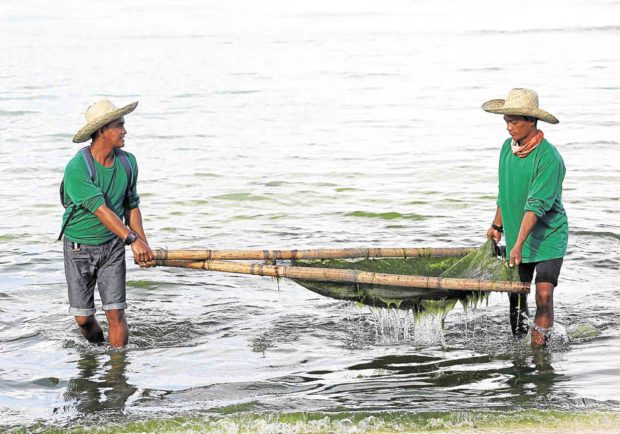Search for poop pipes starts

Workers collect algae from the beaches of Boracay Island. Many say algal bloom is a normal occurrence in Boracay during summer but some suspect that it’s one of the effects of human and animal feces being thrown directly into the sea. —LYN RILLON
BORACAY ISLAND, Aklan—High-tech gadgets usually used to detect minerals underground are being tapped to uncover hidden pipes discharging untreated wastewater into the sea off this resort island.
Members of a DENR team use a high-tech ground penetrating radar device to detect underground pipes illegally discharging into the waters of Boracay Island @inquirerdotnet @inquirervisayas pic.twitter.com/BydynsU7Yn
— Nestor Burgos Jr. (@nburgosjr) May 19, 2018
At least 33 sites believed to be with buried illegal pipes have been detected along the island’s beach by ground-penetrating radar (GPR) devices.
Three of the sites have been confirmed and dug up, according to Environment Secretary Roy Cimatu.
War room
Article continues after this advertisementLiza Socorro Manzano, supervising science research specialist and team leader of the Mines and Geosciences Bureau of the Department of Environment and Natural Resources (DENR), said experts were using an SIR 4000 GPR device to locate the pipes and for an inventory of sinkholes and caves on the island.
Article continues after this advertisementThe top-of-the-line device can detect objects 7 meters underground and is capable of high-resolution imaging and printouts similar to ultrasound test results.
The GPR uses electromagnetic waves to detect objects underground and results are transmitted to a receiver, where they are stored.
The collected data can be evaluated on site but the DENR team in Boracay processes and evaluates data in a “war room” at a resort here.
While it cannot reflect and print out images of pipes, anomalies that could mean buried objects can be detected through the results.
The device can detect all types of pipes including those made of steel, PVC and concrete to up to 7 m underground.
Manzano told reporters in a briefing here with Cimatu that the maximum depth of the buried pipes was about 2.5 m.
Septic tank
The results of the GPR device scans are completed by satellite images and actual physical inspection of the suspect sites.
Manzano said the number of suspect sites at the western side of the island is about “40 and counting,” with 18 sites as priority. The sites could contain one to dozens of interconnecting pipes.
In one excavation site dug using a backhoe, the DENR team discovered a septic tank that was just 10 m from the beach.
Cimatu said this would explain the erratic results of water quality tests even as the island had been closed to tourism starting on April 26.
Cimatu said experts would locate the source of the pipes and identify the establishments that were responsible.
“They will face the maximum penalty,” Cimatu said. Penalties could include fines of millions of pesos daily.
The DENR will use the GPR device to detect illegal pipes along Bolabog Beach at the eastern side of the island, where coliform bacteria level is above acceptable standards.